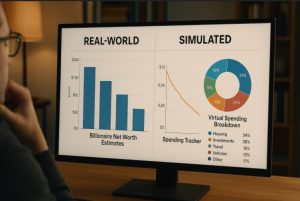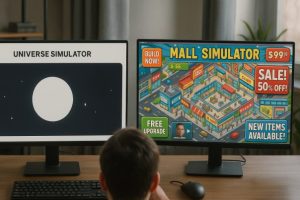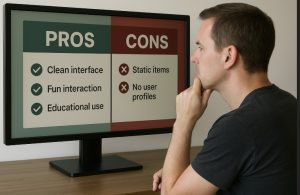In today’s digital entertainment landscape, simulation games have taken a fascinating turn. One game that continues to draw significant attention is Spend Mark Zuckerberg Money on Neal.fun.
Built around the idea of virtually spending $100 billion, the game taps into both the curiosity and the social commentary surrounding extreme wealth.
The platform presents a highly engaging, timer-based simulation that allows users to spend Mark Zuckerberg’s hypothetical fortune on a wide range of products from garbage bags to yachts and IT infrastructure.
While it seems playful on the surface, the experience also subtly underscores issues like income disparity, spending psychology, and how far tech wealth can stretch.
What Is the ‘Spend Mark Zuckerberg Money’ Game on Neal.fun?

The ‘Spend Mark Zuckerberg Money’ simulation on Neal.fun is a web-based experience that immerses users in the task of spending $100 billion virtually.
It was developed by Neal Agarwal, the creator of several interactive, thought-provoking mini-projects on Neal.fun. This simulation stands out for its mix of humour, psychology, and educational value.
Unlike conventional games, there are no scores, leaderboards, or objectives. The real “win” comes from seeing how much—or how little you can buy with a fortune that mirrors Zuckerberg’s estimated wealth.
The game’s simplicity and accessibility have made it especially popular among students, casual gamers, and those interested in the ethics of extreme wealth.
- Created by web developer Neal Agarwal as part of a larger portfolio of simulation-based content
- Designed to be both entertaining and educational with no log-in or download required
How Does the Billionaire Money Simulator Work?
The simulator opens with a default balance of $100,000,000,000 and a list of items available for purchase. These range from mundane products like stationery to high-ticket items such as helicopters and commercial properties. Each item is accompanied by a price and a quantity counter, allowing users to click repeatedly to purchase multiple units.
There’s also a timer feature. This optional setting starts a countdown as soon as you begin, adding urgency to your decisions and gamifying the process. A print receipt function allows users to generate a summary of their spending, which can be saved, printed, or shared.
- Users can click to purchase items multiple times, updating totals in real time
- The receipt provides a running log of transactions for review or educational use
Why Is This Game So Popular Among UK Users?

In the UK, where economic inequality and wealth transparency are frequently discussed topics, this game resonates on a deeper level. The simplicity of Neal.fun’s format, paired with the massive virtual fortune, makes it perfect for sparking discussions about income disparity.
Students and educators alike use the platform as an informal educational tool, while casual gamers enjoy the challenge of trying to deplete the entire $100 billion balance. British users, particularly on forums like Reddit UK and TikTok, often turn the simulation into a social experiment or personal challenge.
- Popular among teachers for lessons on financial literacy and wealth inequality
- Frequently shared on UK-based social media platforms for its novelty and message
What Can You Buy with Zuckerberg’s Net Worth in This Simulation?
In the Spend Mark Zuckerberg Money simulator on Neal.fun, players are given control over a staggering virtual fortune of $100,000,000,000.
With this simulated net worth, users can scroll through an extensive catalogue of purchasable items, from everyday essentials to industrial-scale assets and luxury real estate.
The simulation offers a unique perspective on just how far billionaire wealth can go when broken down into real-world items and services.
A Virtual Marketplace of Everything from Burgers to Yachts
The purchasing options are arranged in ascending order based on cost, allowing players to start with inexpensive, daily-use products and gradually work their way up to multi-million dollar assets. Here’s how the journey unfolds:
Everyday Essentials and Small Comforts
These low-cost items offer a surprising look at how virtually endless the billionaire budget feels in the beginning stages of spending. Even after buying thousands of units of these, your budget would barely move.
- Garbage Bag – $2
- Note Papers Pack – $4
- Smasher Burger – $12
- Liquorice Stick Bundle – $22
- Cuisine Spice Pack – $39
- Hand Tool Kit – $48
Despite their practicality or enjoyment value, items at this price point require hundreds of thousands of units to make a dent in the overall $100 billion. This is often the first eye-opening moment for players as they realise the sheer magnitude of Zuckerberg’s wealth.
Mid-Tier Consumer Goods and Electronics
As users scroll further, consumer tech and entertainment products begin to appear. These items are priced within reach for many consumers in real life, but they still feel trivial in this simulation.
- Nintendo Switch Pro Controller – $66
- Call of Duty Game – $72
- PS3 Normal Edition – $75
- Quality Glove – $110
- Grey Cat – $180
- Puppy Dog – $200
- Samsung Gear VR – $230
- Roller Skates – $290
- Android TV Smart – $300
At this stage, users often experiment with combinations of household items, pets, and gadgets. Even extravagant purchases like 1,000 Android TVs only total $300,000—barely 0.3% of a single billion.
High-End Lifestyle and Furnishings
This tier includes more luxurious home and lifestyle options. The costs climb gradually, but they’re still well within what an upper-middle-class consumer might afford with careful planning.
- Women Shoes M22 – $320
- Ultra Fan (Combo) – $340
- Sony Professional Camera – $380
- Elderwide Fish Pack – $450
- Ultra Fast Food Pack – $550
- Italian Cuisine Pasta Organic – $750
- Table Couch Furniture Bed Chair – $799
Spending begins to feel more meaningful here, but even with thousands of dollars spent, you remain far from making a real impact on the $100 billion figure.
Advanced Tech and Heavy Machinery
Now we approach assets designed for commercial use or advanced tech sectors. Buying just one of these could cost more than a house in many UK regions.
- Intel Megaport Gaming Computer – $1,200
- Metal Lathe Machine – $2,000
- Sany Excavator – $15,000
- Commercial Dump Truck – $20,000
- Ford Mustang Coupe (2015) – $33,000
These purchases begin to create visible reductions in your total, particularly when users opt to buy them in bulk. It introduces a new layer of spending psychology: how would a billionaire allocate funds between innovation and indulgence?
Luxury Assets and Vehicles
At this level, the game takes a turn into elite billionaire territory, giving players access to luxury vehicles, watercraft, and transport assets that are rarely seen outside the wealthiest circles.
| Item | Price |
| Black Audi V13 | $3,000,000 |
| ALDORA Transport Ship | $3,500,000 |
| Building Apartment (Commercial) | $5,000,000 |
| Helicopter Rotor Aircraft | $5,500,000 |
| IT Infrastructure Data Centre | $9,000,000 |
| Smart Industrial Robot | $10,000,000 |
| Watercraft Yacht | $11,000,000 |
| Resort Near Beach Land | $15,000,000 |
| Louvre Museum | $20,000,000 |
Players can mix and match purchases, simulate real estate empires, or invest in technological expansion. Buying five data centres and ten robots still only totals around $140 million—barely over 0.1% of the virtual net worth.
Time Pressure and Strategic Spending
To make the experience even more immersive, the simulator offers a default timer. Once activated, players must make rapid decisions under time pressure, testing their instinctual financial behaviours. The timer gamifies the experience, adding urgency similar to the pressure tech executives may face during high-stakes business decisions.
- The timer forces faster spending and less deliberation
- It helps users appreciate the difficulty of spending wisely under pressure
Transparent Spending with a Receipt Feature
Every purchase is logged through a built-in print receipt feature, allowing users to track and review their entire spending history. This not only adds a layer of accountability but also transforms the simulator into a self-contained economic exercise. Users often share their receipts online, sparking comparisons and debates about the best (or most bizarre) spending strategies.
How Accurate Is the Mark Zuckerberg Net Worth in the Game?

The simulator bases its virtual wealth on public estimates of Mark Zuckerberg’s net worth, particularly from sources like Bloomberg Billionaires Index and Forbes. While these figures are not updated in real time, $100 billion is a reasonable, rounded approximation that allows users to grasp the scale of tech billionaire wealth.
The prices of items in the simulator are also grounded in reality, giving users a tangible sense of what these purchases would cost in the real world. Although simplified, the game paints a fairly accurate picture of spending power on that scale.
| Detail | Description |
| Net Worth Used | $100 billion (rounded approximation) |
| Pricing Reference | Based on market values and online retail |
| Data Source | Forbes, Bloomberg, product marketplaces |
This accuracy makes the experience more immersive and meaningful, especially when used in classrooms or discussion settings.
Is the Neal.fun Simulation Just for Fun or Educational Too?
While undeniably entertaining, the simulator also carries strong educational undertones. It has been adopted in schools and universities to facilitate discussions around economics, philanthropy, and ethical responsibility.
By forcing users to choose between high quantities of low-value items or a few monumental purchases, the game demonstrates how wealth can be distributed or concentrated. It’s not uncommon for players to simulate social change through their spending—like buying thousands of food packs or educational tools.
- Highlights the disparities between everyday necessities and luxury items
- Encourages critical thinking about wealth, ethics, and resource allocation
What Are the Key Differences Between Neal.fun and Other Billionaire Simulators?

Many money simulation games exist online, but Neal.fun’s version has a distinct design philosophy. It strips away unnecessary complexity, focusing instead on interaction, reflection, and simplicity. There are no avatars, currencies, or complex rule sets. Just a scrolling interface with clickable items and a dollar tracker.
Compared to similar apps or games, Neal.fun stands out by offering:
- A browser-first experience with no need for installation or login
- A minimalist aesthetic with strong user interface clarity
- Fast, intuitive gameplay suitable for all ages and skill levels
Most importantly, the platform’s focus isn’t just on fun, but on instigating questions—about consumerism, capitalism, and the value of money.
Can You Play the Mark Zuckerberg Simulator on Mobile Devices?
Yes, Neal.fun is mobile-optimised and performs well across smartphones and tablets. The user interface adapts seamlessly to smaller screens, and the purchase buttons remain easy to use.
Though performance varies slightly depending on browser and device, all major platforms (Chrome, Safari, Firefox) support the simulation without lag or loss of functionality. The one area where desktops have an advantage is in ease of scrolling, especially through the longer list of items.
- Compatible with iOS and Android operating systems
- Fully functional features including timer and receipt on mobile
How Can You Share Your Spending Results or Challenge Friends?
Although the simulation does not include built-in sharing options or logins, many users capture their results using screenshots. The printed receipt feature is particularly useful for this, as it lists every purchase made along with the total money spent.
Users on Reddit, Twitter, and other platforms often create challenges such as:
- Spend the entire fortune only on helpful or philanthropic items
- Deplete the balance in the shortest possible time
- Compete with friends on creative or funny spending combinations
These organically created challenges have helped the game spread virally, especially among younger demographics interested in social commentary or minimalist gaming.
What Are the Pros and Cons of the Neal.fun Spending Simulator?

Here’s a quick summary comparing the key strengths and limitations of the game:
| Pros | Cons |
| Accessible to anyone with an internet browser | No multiplayer or collaboration features |
| Educational and socially relevant | Static item list with no user customisation |
| Engaging timer and print receipt tools | Wealth figure is not dynamically updated |
| Clean design with no ads | No long-term save or profile function |
The game’s balance between entertainment and meaning is what makes it a standout experience. While it doesn’t aim to be comprehensive or deeply realistic, it succeeds in making wealth tangible in a way that’s interactive, surprising, and fun.
Conclusion
The Spend Mark Zuckerberg Money game on Neal.fun offers more than just amusement. It’s a powerful tool that challenges how people perceive wealth, decision-making, and value.
Its sleek design and wide array of purchasing options allow users to explore the scale of billionaire wealth in an interactive and informative way.
Whether you’re curious about tech moguls, exploring economics, or just want a break from typical games, this simulation provides a unique, educational experience that has rightly earned its place among the most intriguing online simulators.
FAQs
What is the purpose of the Spend Mark Zuckerberg Money simulator?
The game is designed to offer insight into the scale of billionaire wealth while also serving as a fun and engaging simulation experience.
Is this simulator suitable for children or educational use?
Yes, many educators use it to teach lessons in finance, economics, and ethics. The content is safe and age-appropriate.
Can players customise the items or add new ones?
No, the item list is static and cannot be edited or customised by users.
Does this game collect personal data?
No, Neal.fun does not require login or personal data to use the simulation.
How long does it take to spend all $100 billion?
It varies based on user strategy. Some take hours, others race the clock using the timer mode to do it in minutes.
What’s the most expensive item in the simulator?
One of the highest-priced assets is the Louvre Museum, listed at $20 million.
Can users suggest new features to Neal.fun?
Yes, users often share feedback via social media and GitHub. Some suggestions have even been incorporated over time.






